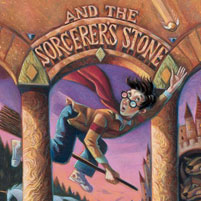The Brain and Harry Potter

Some people say that reading "Harry Potter and the Sorcerer's Stone" taught them the importance of friends, or that easy decisions are seldom right.
Carnegie Mellon University scientists used a chapter of that book to learn a different lesson: identifying what various regions of the brain are doing when people read.
The work is part of CMU's new BrainHub initiative.
Researchers from CMU's Machine Learning Department performed functional magnetic resonance imaging (fMRI) scans of eight people as they read Chapter 9, which described Harry's first flying lesson.
"It turns out that movement of the characters — such as when they are flying their brooms — is associated with activation in the same brain region that we use to perceive other people's motion," said Leila Wehbe, a Ph.D. student in CMU's School of Computer Science, which is celebrating its 25th year. "Similarly, the characters in the story are associated with activation in the same brain region we use to process other people's intentions."
That kind of information was gleaned by analyzing the scans, cubic millimeter by cubic millimeter, for every four-word segment of that chapter.
The result was the first integrated computational model of reading, identifying which parts of the brain are responsible for such subprocesses as parsing sentences, determining the meaning of words and understanding relationships between characters.
Wehbe and Tom Mitchell, the department head, reported in the online journal PLOS ONE that the model was able to predict fMRI activity for novel text passages with sufficient accuracy to tell which of two different passages a person was reading with 74 percent accuracy.
"At first, we were skeptical of whether this would work at all," Mitchell said, noting that analyzing multiple subprocesses of the brain at the same time is unprecedented in cognitive neuroscience. "But it turned out amazingly well and now we have these wonderful brain maps that describe where in the brain you're thinking about a wide variety of things."
Wehbe and Mitchell said the model is still inexact, but might someday be useful in studying and diagnosing reading disorders, such as dyslexia, or to track the recovery of patients whose speech was impacted by a stroke. It also might be used by educators to identify what might be giving a student trouble when learning a foreign language.
"If I'm having trouble learning a new language, I may have a hard time figuring out exactly what I don't get," Mitchell said. "When I can't understand a sentence, I can't articulate what it is I don't understand. But a brain scan might show that the region of my brain responsible for grammar isn't activating properly, or perhaps instead I'm not understanding the individual words."
This research was supported by the National Science Foundation, the National Institute of Child Health and Human Development and the Rothberg Brain Imaging Award.
Related Links: Press Release | BrainHub
